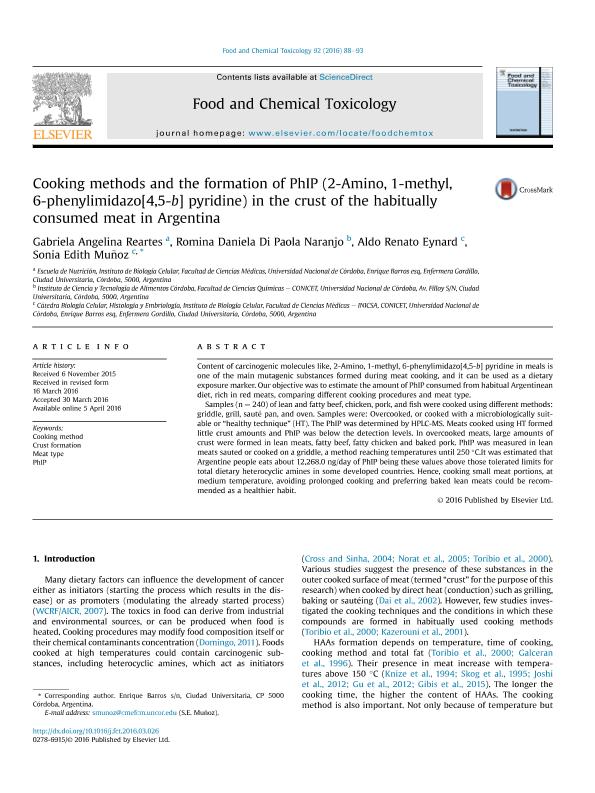Artículo
Cooking methods and the formation of PhIP (2-Amino, 1-methyl, 6-phenylimidazo[4,5-b] pyridine) in the crust of the habitually consumed meat in Argentina
Reartes, Gabriela Angelina; Di Paola Naranjo, Romina Daniela ; Eynard, Aldo Renato
; Eynard, Aldo Renato ; Muñoz, Sonia Edith
; Muñoz, Sonia Edith
 ; Eynard, Aldo Renato
; Eynard, Aldo Renato ; Muñoz, Sonia Edith
; Muñoz, Sonia Edith
Fecha de publicación:
06/2016
Editorial:
Pergamon-Elsevier Science Ltd
Revista:
Food And Chemical Toxicology
ISSN:
0278-6915
Idioma:
Inglés
Tipo de recurso:
Artículo publicado
Clasificación temática:
Resumen
Content of carcinogenic molecules like, 2-Amino, 1-methyl, 6-phenylimidazo[4,5-b] pyridine in meals is one of the main mutagenic substances formed during meat cooking, and it can be used as a dietary exposure marker. Our objective was to estimate the amount of PhIP consumed from habitual Argentinean diet, rich in red meats, comparing different cooking procedures and meat type.Samples (n = 240) of lean and fatty beef, chicken, pork, and fish were cooked using different methods: griddle, grill, sauté pan, and oven. Samples were: Overcooked, or cooked with a microbiologically suitable or "healthy technique" (HT). The PhIP was determined by HPLC-MS. Meats cooked using HT formed little crust amounts and PhIP was below the detection levels. In overcooked meats, large amounts of crust were formed in lean meats, fatty beef, fatty chicken and baked pork. PhIP was measured in lean meats sauted or cooked on a griddle, a method reaching temperatures until 250 °C.It was estimated that Argentine people eats about 12,268.0 ng/day of PhIP being these values above those tolerated limits for total dietary heterocyclic amines in some developed countries. Hence, cooking small meat portions, at medium temperature, avoiding prolonged cooking and preferring baked lean meats could be recommended as a healthier habit.
Palabras clave:
Cooking Method
,
Crust Formation
,
Meat Type
,
Phip
Archivos asociados
Licencia
Identificadores
Colecciones
Articulos(INICSA)
Articulos de INSTITUTO DE INVESTIGACIONES EN CIENCIAS DE LA SALUD
Articulos de INSTITUTO DE INVESTIGACIONES EN CIENCIAS DE LA SALUD
Citación
Reartes, Gabriela Angelina; Di Paola Naranjo, Romina Daniela; Eynard, Aldo Renato; Muñoz, Sonia Edith; Cooking methods and the formation of PhIP (2-Amino, 1-methyl, 6-phenylimidazo[4,5-b] pyridine) in the crust of the habitually consumed meat in Argentina; Pergamon-Elsevier Science Ltd; Food And Chemical Toxicology; 92; 6-2016; 88-93
Compartir
Altmétricas



